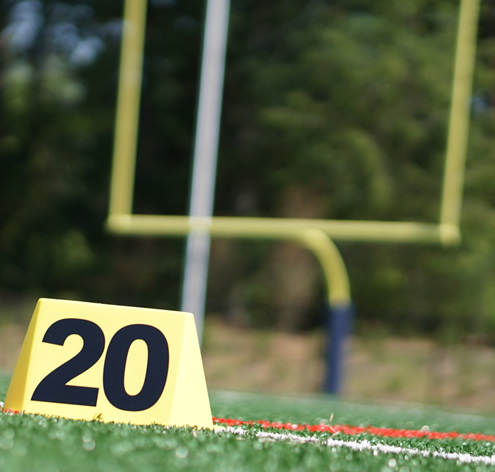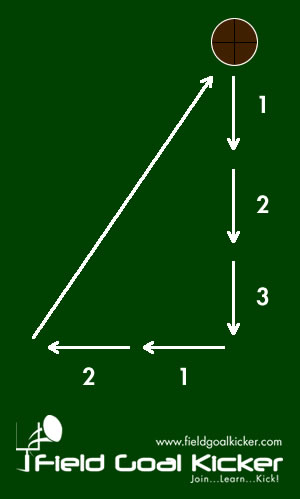Field Goal Kicking Tips
 Field goal kicking tips seem to litter the web these days, especially on YouTube, where instructional style videos are all over the board! Just search for anything field goal kicking related and you will probably find yet another version of someone demonstrating a kicking tip of some sort.
Field goal kicking tips seem to litter the web these days, especially on YouTube, where instructional style videos are all over the board! Just search for anything field goal kicking related and you will probably find yet another version of someone demonstrating a kicking tip of some sort.
Most every kicker or punter that contacts me for private kicking lessons has seen these video variations on YouTube already. Though there is some great information out there, it can be very confusing to sort through the good advice from experienced instructors.
Students also learn in different ways. Some are more visual, some are more verbal, physical, so on and so forth. Watching a video that doesn’t connect in the right way at the right time can be confusing!
Think of kicking as a series of smaller movements from head to toe. It’s our goal to learn each part to the point that it’s automatic, otherwise known as creating muscle memory. As I always say during my lessons….master the parts first, then gradually those parts come together to create a beautiful and efficient swing whether your kicking or punting.
Learning one concept without a firm grasp or understanding of another might actually hurt a budding kicker more than help.
Some of the finer points of kicking that may have been taken for granted when I was ‘doing’ really reveal themselves when ‘teaching’ so I’m going to try and help with some of my favorite field goal kicking tips below!
Kicking Tip Focus: Beginner versus Advanced
I’ve worked with students from 8 years of age to college level over the past few years. The biggest mistake I see over and over, is that students tend to focus on the wrong things at the wrong time within their development and learning.
 For instance, a beginner kicker who’s never played soccer is usually very different than a long time soccer player who is learning to kick field goals for the football team. In the situation of the kicker who’s never kicked a soccer ball, he must ‘train his brain’ to learn what a kick with the instep actually feels like.
For instance, a beginner kicker who’s never played soccer is usually very different than a long time soccer player who is learning to kick field goals for the football team. In the situation of the kicker who’s never kicked a soccer ball, he must ‘train his brain’ to learn what a kick with the instep actually feels like.
To these ‘non soccer’ students, the perception of ‘kicking’ a ball often means something different (like kicking more with the toe or only the area around the end of the foot.) So, we’re often going to focus on the approach to the ball and what that feels like before jumping right to the contact points on the foot and the ball itself.
A soccer player already has that muscle memory and is often very comfortable with the approach and the instep kick in general. I do find however, that most often these new ‘soccer player’ kickers need to focus on an understanding of the optimal contact points both on the ball and the foot in a first session.
To some degree, think of kicking much like martial arts. Every student comes in somewhere between a white and black belt. When they go online as a white belt (complete beginner) and study video concepts more fitting for a more advance blue or purple, it’s just confusing!
Beginner Field Goal kicking Tips
For the beginning kicker, the most common two issues I see are related to:
- Approach distance
- Contact
Let’s take a look at both for some quick fundamental corrections that might help the beginner kicker!

1) Approach Distance
I see LOTS of young beginners (even soccer players) line up WAY too far back behind the ball. Kickers instinctively step back a good 4-6 steps behind the ball, then run at it like they are competing in a backyard kick ball game. This is no good!
Why? A kicker will never have time to take this many steps at the ball during a game. The kick will get blocked among other bad things that are likely to happen. Remember this….THREE steps back, TWO steps over.
For a right footed kicker, this means taking three comfortable steps back from the ball, then take two comfortable (shoulder width) steps to the left. It is of course opposite (two steps to the right) for the lefty kicker.
You can of course, adjust from these steps slightly, but the 3 back 2 over is almost universal so it’s a good starting point and will get the beginner in the game. From here, he can simply take one small jab step with the left foot, then a lead step with the right foot, followed by a plant beside the ball with the left foot.
As I tell my students in person….it’s a coordinated approach, LEFT, RIGHT, KICK!
2) Contact
Contact is often the BIGGEST offender with kicking that I see. Even for advanced kickers, they often may be kicking the ball in the right location (on the ball), but they aren’t making ideal contact on the foot. They are often kicking too low on the foot. Think about kicking more toward the ankle, not toward the big toe….go higher versus lower on the foot.
This may come as a shock to the absolute beginner, but there is NO TOE allowed! The instep is a part of the foot that some of you NEVER considered might be used to kick a ball, let alone a football.
 So, where and what is the instep?
So, where and what is the instep?
If you will reach down and feel your foot right now, there is a bone on the top of your foot that you can feel plain as day.
It’s called the navicular bone, and its one the inside of the top of your foot as you look from the top down (that would be the left side of your right foot or the right side of your left foot).
If you are making contact with any other part of the foot when contacting the ball, you are not kicking soccer style, which is the standard for field goal kicking today.
Some beginners think that kicking offer style means starting the approach to the ball from the side rather than directly behind the ball. However, this is not what makes a soccer style kick because they are still kicking the ball with their toe!
No, it’s about the approach and contact for the beginning kicker nine times out of ten in my experience. If you kick with the instep then you will have to approach from the side, naturally.
Field Goal Kicking Tips For Advanced Place Kickers
So, that’s two quick and common field goal kicking tips for beginners, but what about advanced kickers? Drum roll please…..here are the two of the most common corrections I most often make with more advanced kickers:
- Contact on the foot at impact
- Leverage/tempo to the ball
With advanced kickers, we aren’t trying to teach them to kick as much as simply trying to optimize the swing for consistency. A more efficient swing means less effort and more consistency.
1) Contact on the Foot at Impact
Similar to the beginner, oftentimes I see advance kickers using the wrong part of the foot when kicking. Because so many other parts of the swing might be working for them to some degree, they’ve likely been kicking this way for years! They can even be kicking 45 yard field goals with this little contact issue by muscling the ball through.
However, take a look at the image above and recognize that there is one and only one ideal ‘sweet spot’ on the foot itself. Striking the ball this way, putting the BONE in the BELLY of the ball will make a huge difference for the average kicker who isn’t doing it consistently. Less effort, deeper impact sound, less pain on the foot, bigger ball, bigger smile (I’ve seen it too many times.)
2) Leverage/tempo to the Ball
Most advanced kickers are trying too hard…WAY too hard. Their swing looks like a death kick to some degree. I know this because I used to kick this way in college. I had some pretty big kicks early in my career, but when I watch video from way back I completely understand the inconsistency overall.
How do you know if you are swinging too hard? You have a tendency to contort into a full body ‘crunch’ at impact. One kick might sail true, but the next one could be in the stands. Why? It’s tough to repeat the contact when your head, shoulder and eyes are slamming downward as you try to make the ideal contact at the same time.
So, get used to slowing down the approach, standing tall at impact and using BOTH arms during the swing. You’ll find much better contact consistency (foot on the ball), fewer injuries (kicking at 80% versus %100) and happier kicking in general.
For more field goal kicking tips, sign up for an FGK kicking membership for online coaching and field goal kicking community training!
Happy kicking!
